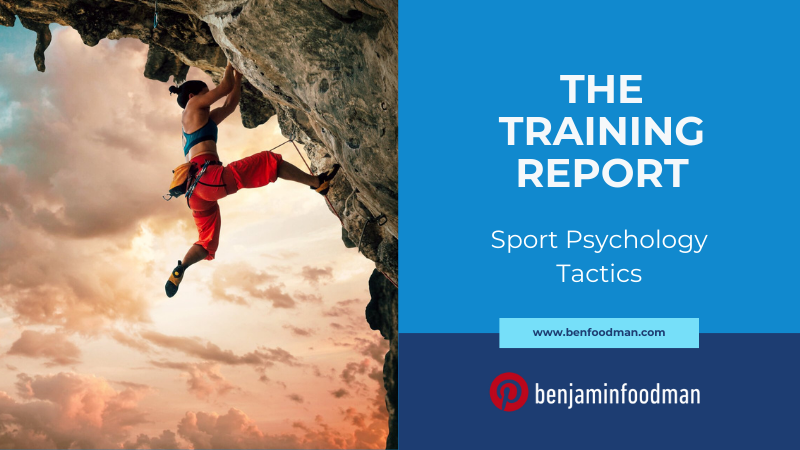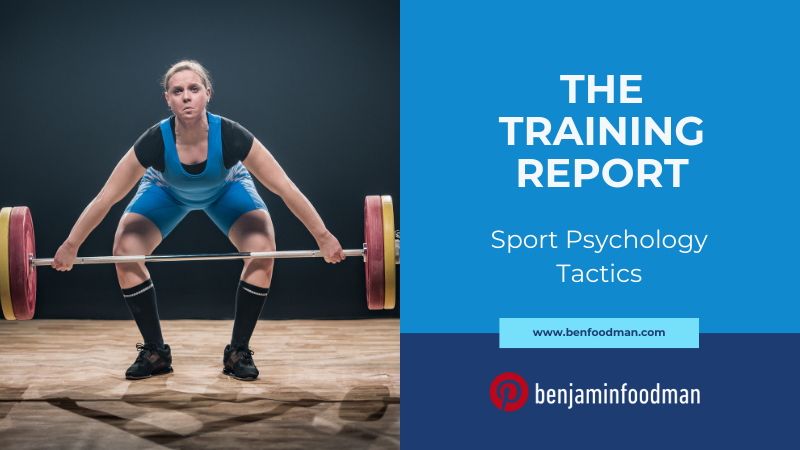Sport Psychology Tactics - Golf, The Yips & How To Use Brainspotting For These Mental Blocks
About the Author
Ben Foodman is a licensed psychotherapist & performance specialist. He owns his private practice located in Charlotte North Carolina where he specializes in working with athletes to help them overcome mental blocks (the yips), PTSD, ADD / ADHD and achieve flow states through the techniques of Brainspotting & Neurofeedback. If you are interested in services, use the link here! Enjoy the article below!
Introduction: Golf Athletes, The Yips & Sport Psychology
Golf is considered to be one of the most psychologically demanding sports. A golf athlete walks up to the tee, makes their shot, and then has an extended period of time to reflect on their performance. The constant pace of performing and then breaking can make it extremely difficult to get into a ‘rhythm’ which is why I believe this sport is so unique from a mental performance standpoint. These intense performance experiences can result in golfers developing mental blocks (AKA the Yips). Interestingly in my work with this population there is still a huge misunderstanding about the yips, and what the most effective sport psychology technique would be to address this issue.
For today’s Training Report, I want to take some time to discuss the Yips in golf. First in part I. we will review how golf can create the yips. Next in part II., we will review the neuroscience principles that explain why this happens and then in part III. we will review a new sport psychology approach that is becoming popular amongst golfers called Brainspotting. I will also discuss a Brainspotting strategy that athletes can use during competition to enhance the possibility of a flow state in part IV. For now, lets review what the yips are and how the neuroscience of golf athletes makes this a unique issue to work through.
Part I. What Are The Golf Yips (AKA Mental Blocks)?
The yips was a term that originally became famous in baseball. Essentially, when certain baseball players that were known for performing at a high level started to experience unexplainable performance setbacks (e.g. no presence of physical injuries but unable to physically perform), coaches would refer to this event at the yips. The yips are a mental block, and the majority of coaches and sport psychologists view mental blocks as the ‘primary diagnosis’, meaning that when an athlete is unexplainably performing poorly, this ‘mental block’ is the ‘disease’ that must be directly treated. The majority of sport psychology interventions that are used to ‘directly address’ this issue will use some form of either cognitive behavioral therapy (a type of psychological intervention aimed at addressing distorted thinking and replacing bad thoughts with good thoughts) or some type of self-calming intervention like deep breathing.
The golf environment is perfectly tailored towards creating mental blocks in golfers. At its’ core, golf is a problem solving experience that is meant to extract maximum psychological and physical resources from the athletes. Golfers have to solve the problem of hitting a ball into different holes as few times as possible, at a variety of distances through dynamic environments. Because experiencing this ‘problem solving’ event can take hours, golfers can experience a tremendous amount of stress. Unfortunately, too much of this type of stress can affect other psychological issues that golfers may not have been consciously aware of, such as unprocessed trauma. Let’s explore the neuroscience behind this, and why this matters.
Part II. The Neuroscience Of The Golf Yips
There are two main areas of the brain I want to focus on: the neocortex and the subcortical brain structures. The neocortex is involved with brain functions known as executive functioning skills (These skills underlie the capacity to plan ahead and meet goals, display self-control, follow multiple-step directions even when interrupted, and stay focused despite distractions, among others). Some people refer to this as top-down processing, and many sport psychologists believe that this area of the brain is primarily responsible for flow states & peak performance (we will explore why this is incorrect near the end of the article). The subcortical brain structures are a collection of different areas of the brain (diencephalon, pituitary gland, limbic structures & basal ganglia) that are responsible for more primal responses (e.g. fight, flight, freeze, fear, etc.). Most importantly, the subcortical brain is the first area of our mind that determines if we are safe or unsafe. Why is this important? Consider anytime you have experienced being startled. Did you consciously choose to respond that way? Probably not. That is because these primal responses are pre-programmed in our brain, meaning that there is no amount of ‘talking or breathing through’ that will prevent these behaviors from happening when we experience high levels of stress. When someone is experiencing the yips, they are presenting with these primal response behaviors, which is an indication that the subcortical brain structures are highly active. Golfers presenting with the Yips are actually experiencing is a symptom of a much deeper issue.
Dr. Bessel Van Der Kolk perfectly explains this problem in his book The Body Keeps The Score: Psychologists usually try to help people use insight and understanding to manage their behavior. However, neuroscience research shows that very few psychological problems are the result of defects in understanding; most originate in pressure from deeper regions in the brain that drive our perception and attention. In this statement Dr. Bessel Van Der Kolk is stating that symptoms such as the Yips / mental blocks are not behaviors where individuals can apply logic to solve them. The yips are symptoms, and the actual problem is most likely a form of unprocessed trauma that has been stored in the body. When I initially explain this to golfers dealing with these issues, there is skepticism that follows. Usually golf athletes will follow up with a statement such as ‘how can I have trauma? I have never been in a warzone or physically abused? I came from a great family, everyone got along great’.
Another way to explain this issue, is more from a sports perspective. In the book This Is Your Brain On Sports by David Grand, the author goes into great detail to explain what Dr. Van Der Kolk said from a slightly different angle: The author describes as follows ‘In parallel fashion, the brain attempts to always move toward a state of psychological equilibrium. Over the course of our lives, we are exposed to a variety of life experiences, some positive, some neutral, and some negative. Through a natural assimilation process, the brain adaptively processes these experiences so they are constructively integrated. What is useful from the experience is learned and stored in the brain with the appropriate emotion and is available for future use. When an experience is successfully assimilated or digested it is stored in the brain with little attached intense emotion or physical sensation. When we recall such an incident, we don’t reexperience the old emotion or sensation with it. In this way we are informed by our past experiences and memories but not controlled by them and with sports our present athletic performances are not burdened by emotional or physical baggage from the past, only learned experience. By contrast, trauma or any strongly negatively charged experience isn’t adequately assimilated or processed. Instead, the upsetting incident remains stuck in the system in broken pieces’.
The author continues, ‘ The body instantly memorizes the physical experience of the trauma in exquisite detail, including the body sensations of the impact and pain, along with the associated sights, sounds, smells and tastes. The attached emotions and where they are felt in the body are frozen as well. The brain is overwhelmed and instead of getting digested, all of the information attached to the injury, including the negative thoughts is stored in the brain in exactly the same form it was initially experienced. Days, week, months or even years later when the athlete is in a situation reminiscent of the original trauma or experiences prolonged stress, the upsetting experience may be unconsciously activated, thus interfering with the performance of the moment. These components represent all of the sensory details from the earlier event that were frozen in the brain and body in their original disturbing state: the images, lighting, emotions, physical movements, sounds, or smells. The unique sensory details later returning to consciousness cause the performance disrupting symptoms so common in mental blocks.’ Again, at the end of the day trauma is just stress that can come in the form of a distressing or disturbing experience. We all handle stress differently, and if you understand the neuroscience behind this then you have a better chance at alleviating your symptoms. So what do we do to fix the yips and move into peak performance?
Part III. Sport Psychology, Athletes & Brainspotting
Sport psychologists are starting to become aware of a new psychotherapy technique called Brainspotting. I have talked about Brainspotting in previous Training Reports, but I want to take some time to explore why it is the perfect intervention for mental blocks in golf. First, what is Brainspotting? Brainspotting is a brain-based psychotherapy technique that utilizes the client’s field of vision to identify unresolved psychological issues. In Brainspotting we say ‘where you look affects how you feel’ and through this process clients have the ability to access the parts of their brain that traditional psychotherapy approaches are unable to do. Because the goal of all sport psychology interventions are to help athletes move from dysregulation to regulation (dysregulation = the yips / mental blocks, regulation = no yips / mental blocks), Brainspotting practitioners focus on the areas of the brain that create dysregulation behaviors. Because almost half of the brain is dedicated to vision, we use the clients field of vision combined with focused mindfulness to help engage these regions of the brain while bypassing the regions that are not! This physiological approach can help athletes achieve their desired psychological outcomes of eliminating the yips. But Brainspotting isn’t just about addressing the ‘negative’ stuff. As previously mentioned you can also use Brainspotting techniques to achieve high levels of focus, such as a flow state. Let’s first explore what a flow state is.
Flow states have been defined as the following: flow state, also known colloquially as being in the zone, is the mental state in which a person performing some activity is fully immersed in a feeling of energized focus, full involvement, and enjoyment in the process of the activity. Many sport psychologists believe that flow states are achieved through increased access to the neocortex. But when we go back to our earlier discussion on neuroscience principles, what we find is that the subcortical brain is primarily responsible for creating flow states. How do we know this? When you look at many of the symptoms associated with dysregulation behaviors (PTSD attacks are dysregulation behaviors described as intense sensations in the body, out of body experiences, time distortion, etc., also known as dissociation) flow states are frequently described in a similar manner (intense body sensations, out of body experiences, time distortion). Athletes that experience flow states most like are experiencing what would be considered a ‘positive’ dissociative experience. So what are some Brainspotting techniques you can use to achieve this positive dissociative experience?
Part IV. Golf Psychology Strategy For Flow States
First, think of a moment where you have lifted heavy weights during an exercise session (e.g. a one rep max on the bench press). What was the process you went through to make sure that your body was prepared to lift the weight? Odds are you probably did some type of body scan making sure that your core and back were tight, you made sure that your hand grip was secure around the bar, took a deep breath and performed the lift. In strength & conditioning we refer to this process as preloading, and when you think about golf shots (e.g. having to drive the ball to a certain part of the fairway, or hitting a golf ball over a sand trap / body of water), every stroke you take requires the same type of psychological process that occurs in heavy weightlifting. You aren’t thinking about whether you will make the heavy lift, but instead you are focused on preparing your body to feel how it needs to feel to properly perform. Because in Brainspotting we are trying to access the parts of the brain that are involved in regulation and dysregulation, going through a preloading process before taking your shot will force you to access these areas of the brain which will create a type of positive dissociative state. So, when you have to make a long drive, or hit the ball over a sand trap to make the green, try the following steps:
Grab the golf club you are going to use and walk up to the area that you will be hitting from
Move your eyes to the exact area that you want your shot to land
Go through the body preloading process, and try to create the same sensations as you would during a heavy weightlifting attempt
Take a deep breath and move on to your pre-shot routine
Hit the ball
Assess if you created the same sensations in your body associated with heavy weightlifting
As I say to all of my clients ‘I’m not batting 1000”. But when I go over this approach with my clients, the majority of athletes I work with describe how this approach helps them ‘get out of their head’. My response to this: I don’t want you to get out of your head, I just want you to be in the right place in your mind! Give this technique a try and see what happens!
Note To Reader:
If you are an athlete reading this segment of the TRAINING REPORT, hopefully this content was helpful! I put the Training Report together because I felt like many of the discussions on issues such as the Yips/mental blocks, strength training & other subject matter on athlete performance concepts were really missing the mark on these ideas (e.g. how trauma is the direct cause of the Yips). If you are interested in learning more, make sure to subscribe below for when I put out new content on issues related to sport psychology & athlete performance! Also, if you are looking to work with a mental performance specialist, you are in the right place! USE THIS LINK to reach out to me to see if my services are the right fit for your goals!
ARE YOU ON THE LIST?
Make sure you’re signed up to Ben’s mailing list to receive news & updates on new strategies in sport psychology, upcoming workshops & products. Don’t wait, sign up now!






















































































